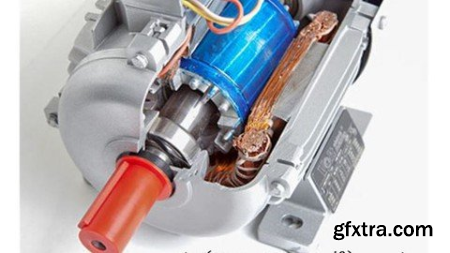
Last updated 2/2022MP4 | Video: h264, 1280x720 | Audio: AAC, 44.1 KHzLanguage: English | Size: 2.30 GB | Duration: 3h 34m
DC motors and 3-phase motors What you'll learn The mathematics of the DC motor The mathematics of the 3-phase asynchronous motor How to derive the equations of the DC motor and the 3-phase asynchronous motor The electromagnetic field generated by the DC motor and 3-phase asynchronous motor the angular velocity and torque of the DC motor and 3-phase asynchronous motor Requirements Kirchhoff's laws the concept of: Inductance, resistance, impedance Faraday-Lenz law of electromagnetism (also Maxwell laws) calculus Description In this course the mathematics of electric motors are derived. In particular, the constitutive equations of the DC motor and the 3-phase asynchronous motor are constructed starting from the principles of electromagnetism.In the DC motor, the analysis of the stator and the rotor will lead us to equations containing the torque generated by the motor, the angular velocity, the current in the armature circuit, the current in the excitation circuit, the electromotive force generated by induction, the excitation flux, and more. We will explain the behavior of the motor through the equations; their derivation will foster comprehensive understanding of the dynamics of the motor.The theory of the 3-phase asynchronous motor will require more lectures to be developed, due to the greater physical and mathematical difficulty of this type of motors. The stator and the rotor are analyzed using complex vectors. First, the electromagnetic field in the air gap between the stator and the rotor is derived, which will then allow to find the flux. Finding the flux is necessary because this physical quantity appears in the constitutive equations of the motor. Besides, the mechanical and electric power generated by the motor will be discussed and mathematically derived in the course, as well as the torque, angular frequency of the rotor, and the parameter called “slip”. The characteristic curve of the torque will also be plotted against the angular velocity of the motor.PrerequisitesStudents should be familiar with complex vectors and calculus. Besides, the knowledge of the following concepts from electromagnetism are recommended:· Kirchhoff's laws· Inductance, resistance, impedance· Faraday-Lenz law of electromagnetism (which stems from Maxwell laws) Overview Section 1: Introduction Lecture 1 Introduction Section 2: DC Motor Lecture 2 DC motor, stator, rotor, constants of the motor Lecture 3 DC motor, equation of the excitation and armature circuit Lecture 4 Constitutive equations of the DC motor Lecture 5 Angular velocity in stationary conditions Section 3: 3-phase asynchronous motor Lecture 6 3-phase asynchronous motor: windings in the stator and rotor Lecture 7 Magnetic field generated by the phases of the stator Lecture 8 Magnetic field generated by the phases of the stator part 2 Lecture 9 Total magnetic field generated by the phases of the stator Lecture 10 Sinusoidal regime of 3-phase asynchronous motors Lecture 11 Electrical power in a 3-phase asynchronous motor Lecture 12 Simplified electrical power, star and triangle configuration Lecture 13 Circuit equations in the stator Lecture 14 Total magnetic field in the air gap Lecture 15 Calculation of the flux in the stator Lecture 16 Circuit equation of the stator in vector space Lecture 17 Fundamental equations of the rotor Lecture 18 Isolating the term related to mechanical power Lecture 19 Considerations on the terms related to energy conservation in the motor Lecture 20 Equations of the 3-phase asynchronous motor in the sinusoidal regime Lecture 21 Angular velocity and torque Lecture 22 Derivation of the equivalent circuit of the 3-phase motor part 1 Lecture 23 Derivation of the equivalent circuit of the 3-phase motor part 2 Lecture 24 Expression for the torque written with respect to frequencies Lecture 25 Simplified expression for the torque Lecture 26 Curve of the torque with respect to angular velocity students who want to understand DC motors and 3-phase asynchronous motors mathematically HomePage:
TO MAC USERS: If RAR password doesn't work, use this archive program:
RAR Expander 0.8.5 Beta 4 and extract password protected files without error.
TO WIN USERS: If RAR password doesn't work, use this archive program:
Latest Winrar and extract password protected files without error.
































